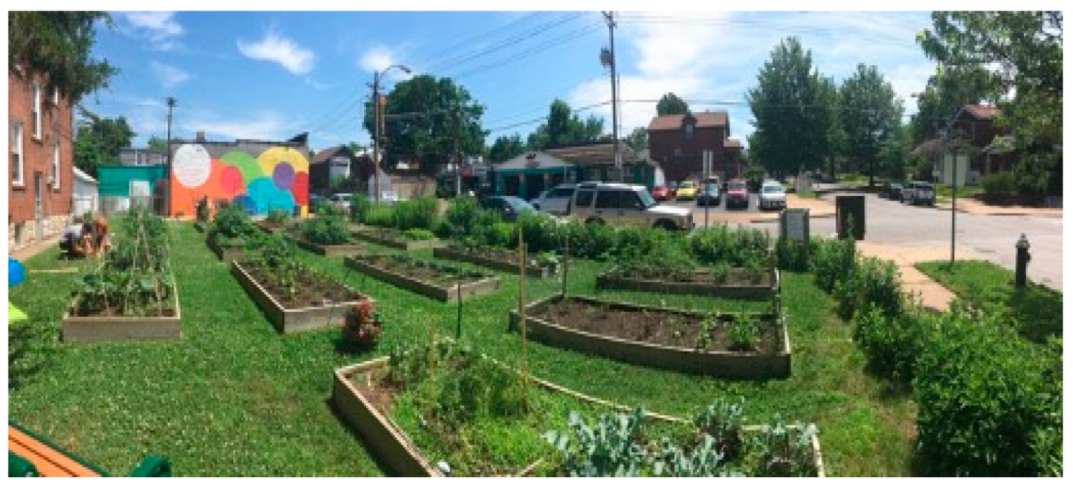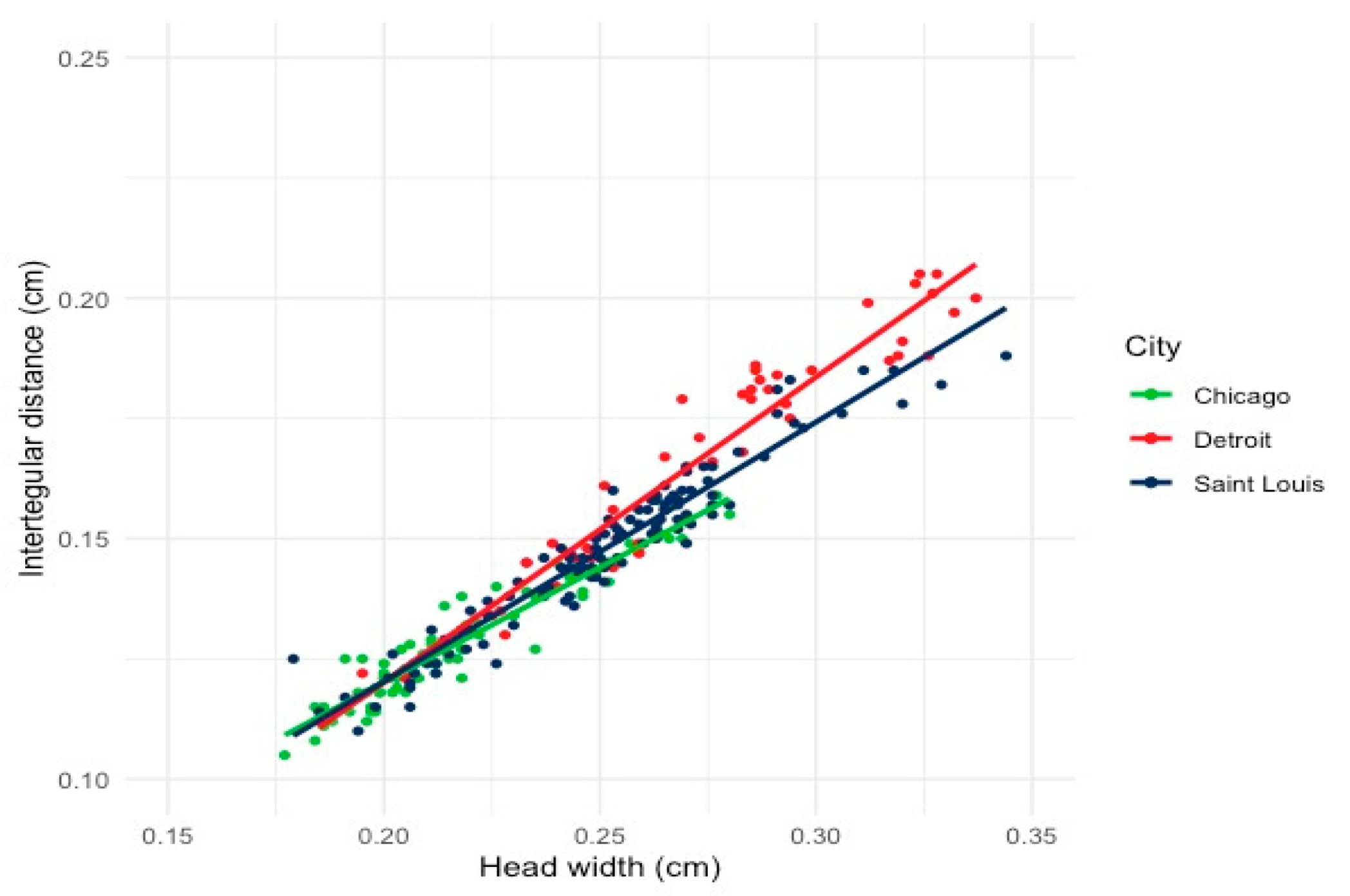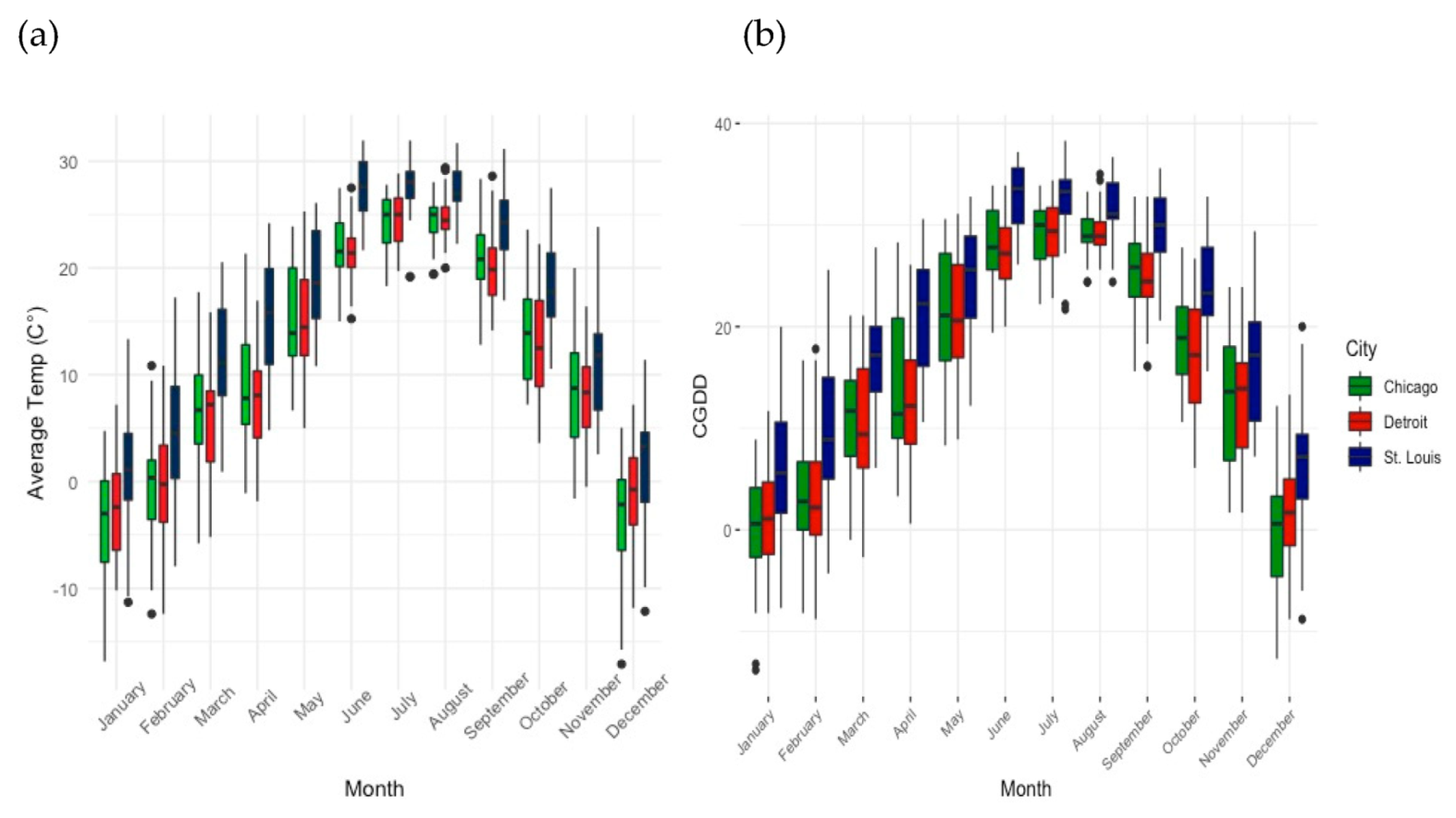Body Size Variation in a Social Sweat Bee, Halictus ligatus (Halictidae, Apoidea), across Urban Environments
Abstract
Simple Summary
Abstract
1. Introduction
2. Materials and Methods
2.1. Survey Methods
2.2. Bee Body Size Measurements
2.3. Statistical Analyses
3. Results
3.1. Does Body Size Variation Differ among Midwestern Cities?
3.2. Do differences in Climate Influence Differences in Body Size Variation?
4. Discussion
5. Conclusions
Supplementary Materials
Author Contributions
Funding
Institutional Review Board Statement
Data Availability Statement
Acknowledgments
Conflicts of Interest
References
- Maitima, J.M.; Mugatha, S.M.; Reid, R.S.; Gachimbi, L.N.; Majule, A.; Lyaruu, H.; Pomery, D.; Mathai, S.; Mugisha, S. The linkages between land use change, land degradation and biodiversity across East Africa. Afr. J. Environ. Sci. Technol. 2009, 3, 310–325. [Google Scholar]
- Ibàñez-Álamo, J.D.; Soler, M. Does urbanization affect selective pressures and life-history strategies in the common blackbird (Turdus merula L.)? Biol. J. Linn. Soc. 2010, 101, 759–766. [Google Scholar] [CrossRef]
- Tryjanowski, P.; Møller, A.P.; Morelli, F.; Biaduń, W.; Brauze, T.; Ciach, M.; Czechowski, P.; Czyż, S.; Dulisz, B.; Golawski, A.; et al. Urbanization affects neophilia and risk-taking at bird-feeders. Sci. Rep. 2016, 6, 28575. [Google Scholar] [CrossRef]
- Chick, L.D.; Strickler, S.A.; Perez, A.; Martin, R.A.; Diamond, S.E. Urban heat islands advance the timing of reproduction in a social insect. J. Therm. Biol. 2019, 80, 119–125. [Google Scholar] [CrossRef] [PubMed]
- Eggenberger, H.; Frey, D.; Pellissier, L.; Ghazoul, J.; Fontana, S.; Moretti, M. Urban bumblebees are smaller and more phenotypically diverse than their rural counterparts. J. Anim. Ecol. 2019, 88, 1522–1533. [Google Scholar] [CrossRef]
- Wenzel, A.; Grass, I.; Belavadi, V.V.; Tscharntke, T. How urbanization is driving pollinator diversity and pollination—A systematic review. Biol. Conserv. 2020, 241, 108321. [Google Scholar] [CrossRef]
- Baldock, K.C.R.; Goddard, M.; Hicks, D.M.; Kunin, W.E.; Mitschunas, N.; Osgathorpe, L.M.; Potts, S.G.; Robertson, K.M.; Scott, A.V.; Stone, G.; et al. Where is the UK’s pollinator biodiversity? The importance of urban areas for flower-visiting insects. Proc. R. Soc. B Biol. Sci. 2015, 282, 20142849. [Google Scholar] [CrossRef] [PubMed]
- Hall, D.M.; Camilo, G.; Tonietto, R.K.; Ollerton, J.; Ahrné, K.; Arduser, M.; Ascher, J.S.; Baldock, K.C.R.; Fowler, R.; Frankie, G.; et al. The city as a refuge for insect pollinators. Conserv. Biol. 2017, 31, 24–29. [Google Scholar] [CrossRef]
- Matteson, K.C.; Langellotto, G.A. Determinates of inner city butterfly and bee species richness. Urban Ecosyst. 2010, 13, 333–347. [Google Scholar] [CrossRef]
- Tonietto, R.; Fant, J.; Ascher, J.; Ellis, K.; Larkin, D. A comparison of bee communities of Chicago green roofs, parks and prairies. Landsc. Urban Plan. 2011, 103, 102–108. [Google Scholar] [CrossRef]
- Fortel, L.; Henry, M.; Guilbaud, L.; Guirao, A.L.; Kuhlmann, M.; Mouret, H.; Rollin, O.; Vaissière, B.E. Decreasing abundance, increasing diversity and changing structure of the wild bee community (hymenoptera: Anthophila) along an urbanization gradient. PLoS ONE 2014, 9, e104679. [Google Scholar]
- Lowenstein, D.M.; Matteson, K.C.; Xiao, I.; Silva, A.M.; Minor, E.S. Humans, bees, and pollination services in the city: The case of Chicago, IL (USA). Biodivers. Conserv. 2014, 23, 2857–2874. [Google Scholar] [CrossRef]
- Davidowitz, G.; D’Amico, L.J.; Nijhout, H.F. The effects of environmental variation on a mechanism that controls insect body size. Evol. Ecol. Res. 2004, 6, 49–62. [Google Scholar]
- Buchholz, S.; Egerer, M.H. Functional ecology of wild bees in cities: Towards a better understanding of trait-urbanization relationships. Biodivers. Conserv. 2020, 29, 2779–2801. [Google Scholar] [CrossRef]
- Camilo, G.R.; Muñiz, P.A.; Arduser, M.S.; Spevak, E.M. A Checklist of the Bees (Hymenoptera: Apoidea) of St. Louis, Missouri, USA. J. Kans. Entomol. Soc. 2017, 90, 175–188. [Google Scholar] [CrossRef]
- McDonnell, M.J.; Hahs, A.K. The future of urban biodiversity research: Moving beyond the ‘low-hanging fruit’. Urban Ecosyst. 2013, 16, 397–409. [Google Scholar] [CrossRef]
- Greenleaf, S.S.; Kremen, C. Wild bee species increase tomato production and respond differently to surrounding land use in Northern California. Biol. Conserv. 2006, 133, 81–87. [Google Scholar] [CrossRef]
- Willmer, P.G.; Finlayson, K. Big bees do a better job: Intraspecific size variation influences pollination effectiveness. J. Pollinat. Ecol. 2014, 14, 244–254. [Google Scholar] [CrossRef]
- Banaszak-Cibicka, W.; Fliszkiewicz, M.; Langowska, A.; Żmihorski, M. Body size and wing asymmetry in bees along an urbanization gradient. Apidologie 2018, 49, 297–306. [Google Scholar] [CrossRef]
- Bolnick, D.I.; Amarasekare, P.; Araújo, M.S.; Bürger, R.; Levine, J.M.; Novak, M.; Rudolf, V.H.; Schreiber, S.J.; Urban, M.C.; Vasseur, D.A. Why intraspecific trait variation matters in community ecology. Trends Ecol. Evol. 2011, 26, 183–192. [Google Scholar] [CrossRef]
- Austin, M.W.; Dunlap, A.S. Intraspecific variation in worker body size makes North American bumble bees (Bombus spp.) less susceptible to decline. Am. Nat. 2019, 194, 381–394. [Google Scholar] [CrossRef]
- Richards, M.H.; Packer, L. Trophic aspects of caste determination in Halictus ligatus, a primitively eusocial sweat bee. Behav. Ecol. Sociobiol. 1994, 34, 385–391. [Google Scholar] [CrossRef]
- Richards, M.H. Annual and social variation in foraging effort of the obligately eusocial sweat bee, Halictus ligatus (Hymenoptera: Halictidae). J. Kans. Entomol. Soc. 2004, 77, 484–502. [Google Scholar] [CrossRef]
- Ksiazek, K.; Tonietto, R.; Ascher, J.S. Ten bee species new to green roofs in the Chicago area. Gt. Lakes Entomol. 2014, 47, 87–92. [Google Scholar]
- Charnov, E.L.; Gillooly, J.F. Thermal time: Body size, food quality and the 10 C rule. Evol. Ecol. Res. 2003, 5, 43–51. [Google Scholar]
- Scharf, I.; Filin, I.; Ben-Yehoshua, D.; Ovadia, O. Phenotypic plasticity and variation in morphological and life-history traits of antlion adults across a climatic gradient. Zoology 2009, 112, 139–150. [Google Scholar] [CrossRef]
- Calovi, M.; Grozinger, C.M.; Miller, D.A.; Goslee, S.C. Summer weather conditions influence winter survival of honey bees (Apis mellifera) in the northeastern United States. Sci. Rep. 2021, 11, 1553. [Google Scholar] [CrossRef]
- Gilbert, N.; Raworth, D.A. Forum: Insects and temperature—A general theory. Can. Entomol. 1996, 128, 1–13. [Google Scholar] [CrossRef]
- US National Oceanic and Atmospheric Administration (NOAA) National Centers for Environmental Information. Daily Summaries January 2015–December 2016. Available online: https://www.ncdc.noaa.gov/cdo-web/datasets/GHCND/locations/CITY:US170006/detail (accessed on 23 November 2021).
- Holland, J.G.; Nakayama, S.; Porfiri, M.; Nov, O.; Bloch, G. Is diversity in worker body size important for the performance of bumble bee colonies? bioRxiv 2020. [Google Scholar] [CrossRef]
- Wilson, C.J.; Jamieson, M.A. The effects of urbanization on bee communities depends on floral resource availability and bee functional traits. PLoS ONE 2019, 14, e0225852. [Google Scholar] [CrossRef] [PubMed]
- Geslin, B.; Le Féon, V.; Folschweiller, M.; Flacher, F.; Carmignac, D.; Motard, E.; Perret, S.; Dajoz, I. The proportion of impervious surfaces at the landscape scale structures wild bee assemblages in a densely populated region. Ecol. Evol. 2016, 6, 6599–6615. [Google Scholar] [CrossRef] [PubMed]
- O’Connell, M.; Jordan, Z.; McGilvray, E.; Cohen, H.; Liere, H.; Lin, B.B.; Philpott, S.M.; Jha, S. Reap what you sow: Local plant composition mediates bumblebee foraging patterns within urban garden landscapes. Urban Ecosyst. 2021, 24, 391–404. [Google Scholar] [CrossRef]
- Peat, J.; Tucker, J.; Goulson, D. Does intraspecific size variation in bumblebees allow colonies to efficiently exploit different flowers? Ecol. Entomol. 2005, 30, 176–181. [Google Scholar] [CrossRef]
- Richards, M. Evidence for geographic variation in colony social organization in an obligately social sweat bee, Lasioglossum malachurum Kirby (Hymenoptera; Halictidae). Can. J. Zool. 2011, 78, 1259–1266. [Google Scholar] [CrossRef]
- Couvillon, M.J.; Dornhaus, A. Location, location, location: Larvae position inside the nest is correlated with adult body size in worker bumble-bees (Bombus impatiens). Proc. R. Soc. B Biol. Sci. 2009, 276, 2411–2418. [Google Scholar] [CrossRef] [PubMed]
- Sutcliffe, G.H.; Plowright, R.C. The effects of food supply on adult size in the bumble bee Bombus terricola kirby (hymenoptera: Apidae). Can. Entomol. 1988, 120, 1051–1058. [Google Scholar] [CrossRef]
- Charnov, E.L. Optimal foraging, the marginal value theorem. Theor. Popul. Biol. 1976, 9, 129–136. [Google Scholar] [CrossRef]
- Jacobson, M.Z. Enhancement of local air pollution by urban CO2 domes. Environ. Sci. Technol. 2010, 44, 2497–2502. [Google Scholar] [CrossRef]
- Klaiber, J.; Najar-Rodriguez, A.J.; Piskorski, R.; Dorn, S. Plant acclimation to elevated CO2 affects important plant functional traits, and concomitantly reduces plant colonization rates by an herbivorous insect. Planta 2013, 237, 29–42. [Google Scholar] [CrossRef][Green Version]
- Lovell, K.L.; Eisenstein, E.M. Dark avoidance learning and memory disruption by carbon dioxide in cockroaches. Physiol. Behav. 1973, 10, 835–840. [Google Scholar] [CrossRef]
- Scherber, C.; Gladbach, D.; Stevnbak, K.; Karsten, R.J.; Schmidt, I.K.; Michelsen, A.; Albert, K.R.; Larsen, K.S.; Mikkelsen, T.N.; Beier, C.; et al. Multi-factor climate change effects on insect herbivore performance. Ecol. Evol. 2013, 3, 1449–1460. [Google Scholar] [CrossRef] [PubMed]
- Curnutte, L.B.; Simmons, A.M.; Abd-Rabou, S. Climate change and Bemisia tabaci (Hemiptera: Aleyrodidae): Impacts of temperature and carbon dioxide on life history. Ann. Entomol. Soc. Am. 2014, 107, 933–943. [Google Scholar] [CrossRef]
- Nicolas, G.; Sillans, D. Immediate and latent effects of carbon dioxide on insects. Annu. Rev. Entomol. 1989, 34, 97–116. [Google Scholar] [CrossRef]
- Myers, S.S.; Zanobetti, A.; Kloog, I.; Huybers, P.; Leakey, A.D.; Bloom, A.J.; Carlisle, E.; Dietterich, L.H.; Fitzgerald, G.; Hasegawa, T. Increasing CO2 threatens human nutrition. Nature 2014, 510, 139–142. [Google Scholar] [CrossRef] [PubMed]
- Fernando, N.; Panozzo, J.; Tausz, M.; Norton, R.M.; Neumann, N.; Fitzgerald, G.J.; Seneweera, S. Elevated CO2 alters grain quality of two bread wheat cultivars grown under different environmental conditions. Agric. Ecosyst. Environ. 2014, 185, 24–33. [Google Scholar] [CrossRef]
- Idso, S.B.; Idso, C.D.; Balling, R.C., Jr. Seasonal and diurnal variations of near-surface atmospheric CO2 concentration within a residential sector of the urban CO2 dome of Phoenix, AZ, USA. Atmos. Environ. 2002, 36, 1655–1660. [Google Scholar] [CrossRef]





| Cities | Diff | Lwr | Upr | p-Value |
|---|---|---|---|---|
| Detroit-Chicago | 0.05 | 0.04 | 0.07 | <1.0 × 10−4 |
| St. Louis-Chicago | 0.034 | 0.02 | 0.05 | <1.0 × 10−4 |
| St. Louis-Detroit | −0.02 | −0.03 | −7.0 × 10−3 | 9.0 × 10−4 |
| Cities | Diff | Lwr | Upr | p-Value |
|---|---|---|---|---|
| Detroit-Chicago | 0.059 | −1.75 | 1.86 | 0.99 |
| St. Louis-Chicago | 4.10 | 2.30 | 5.91 | 3.00 × 10−6 |
| St. Louis-Detroit | 4.05 | 2.24 | 5.85 | 5.00 × 10−6 |
| Cities | Diff | Lwr | Upr | p-Value |
|---|---|---|---|---|
| Detroit-Chicago | −30.62 | −194.53 | 133.30 | 0.90 |
| St. Louis-Chicago | 465.37 | 301.45 | 629.29 | 1.00 × 10−10 |
| St. Louis-Detroit | 495.99 | 332.07 | 659.90 | 1.00 × 10−10 |
| Coefficients: | Estimate | Std. Error | t Value | Pr(>|t|) |
|---|---|---|---|---|
| (Intercept) | 0.22 | 5.83 × 10−3 | 37.73 | <2.00 × 10−16 |
| Month July | −4.54 × 10−3 | 0.01 | −0.38 | 0.70 |
| Month June | −0.02 | 8.09 × 10−3 | −1.93 | 0.05 |
| Month May | 1.46 × 10−3 | 0.02 | 0.09 | 0.93 |
| Month Sep Oct | 0.03 | 0.01 | 2.50 | 0.01 |
| City Detroit | 0.07 | 0.01 | 5.63 | 0.00 |
| City Saint. Louis | 0.02 | 7.55 × 10−3 | 2.87 | 0.00 |
| Month July: City Detroit | −0.02 | 0.02 | −1.30 | 0.19 |
| Month June: City Detroit | 1.85 × 10−3 | 0.02 | 0.09 | 0.93 |
| Month May: City Detroit | −0.03 | 0.02 | −1.31 | 0.19 |
| Month Sep Oct: City Detroit | −0.03 | 0.03 | −1.18 | 0.24 |
| Month July: City Saint. Louis | 5.83 × 10−3 | 0.01 | 0.42 | 0.67 |
| Month June: City Saint. Louis | 0.03 | 0.01 | 3.29 | 1.12 × 10−3 |
| Month May: City Saint. Louis | 0.05 | 0.02 | 2.44 | 0.02 |
| Month Sep Oct: City Saint. Louis | −0.02 | 0.02 | −1.29 | 0.20 |
Publisher’s Note: MDPI stays neutral with regard to jurisdictional claims in published maps and institutional affiliations. |
© 2021 by the authors. Licensee MDPI, Basel, Switzerland. This article is an open access article distributed under the terms and conditions of the Creative Commons Attribution (CC BY) license (https://creativecommons.org/licenses/by/4.0/).
Share and Cite
Brant, R.A.; Camilo, G.R. Body Size Variation in a Social Sweat Bee, Halictus ligatus (Halictidae, Apoidea), across Urban Environments. Insects 2021, 12, 1086. https://doi.org/10.3390/insects12121086
Brant RA, Camilo GR. Body Size Variation in a Social Sweat Bee, Halictus ligatus (Halictidae, Apoidea), across Urban Environments. Insects. 2021; 12(12):1086. https://doi.org/10.3390/insects12121086
Chicago/Turabian StyleBrant, Rachel A., and Gerardo R. Camilo. 2021. "Body Size Variation in a Social Sweat Bee, Halictus ligatus (Halictidae, Apoidea), across Urban Environments" Insects 12, no. 12: 1086. https://doi.org/10.3390/insects12121086
APA StyleBrant, R. A., & Camilo, G. R. (2021). Body Size Variation in a Social Sweat Bee, Halictus ligatus (Halictidae, Apoidea), across Urban Environments. Insects, 12(12), 1086. https://doi.org/10.3390/insects12121086






